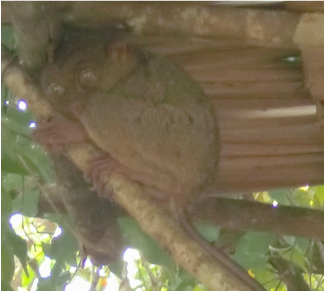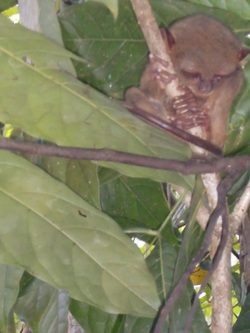Loboc, Bohol, Philippines

One of the smallest known primates on earth, full-grown tarsiers are no bigger than an adult human's hand. They get their name from the long tarsus bones of their hind legs. They are closely related to lemurs, and are often mistakenly called small monkeys.
Their big eyes help them spot insects at night--they're the only known insectivorous primates. And unlike other primates, their eyes don't move in their sockets, but tarsiers can swivel their heads a full 180 degrees.
Because tarsiers are nocturnal, when I visited this reserve in Bohol in the sunny afternoon, most of the tarsiers were sleeping in the shade--and maybe a bit annoyed to be bothered by a bunch of noisy picture-taking tourists.

I was able to see and learn about tarsiers in a net-enclosed forest at the Tarsier Conservation Area in Loboc. There are a couple other spots on the island of Bohol that legally keep tarsiers in protected natural habitat. All are doing more to educate tourists and the local population alike about tarsier conservation and habitat preservation. The Philippine Tarsier Foundation even has a program for volunteers to work at their tarsier sanctuary for a week or two. Sounds like a great field trip for an environmental science class.
Information for this article was taken from the following online sources. If you're interested in learning more about tarsiers, please click on the links.
Copyright © David Rohlfing and Fish Sauce, 2015. All rights reserved. Unauthorized use and/or duplication of this material, including photos and text, without expressed and written permission from this blog's author/owner is strictly prohibited.
 RSS Feed
RSS Feed